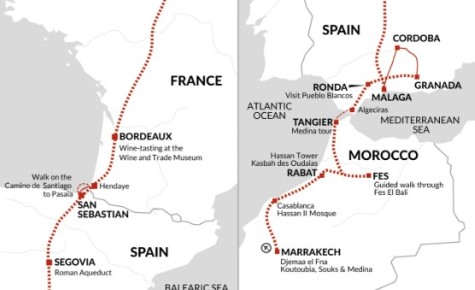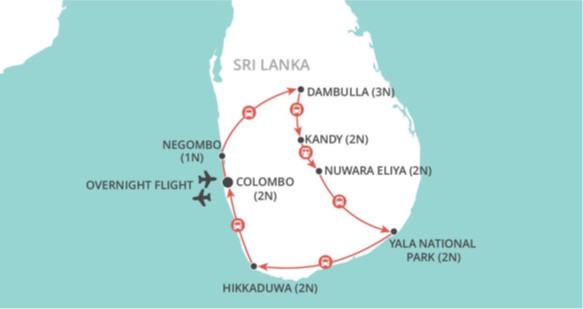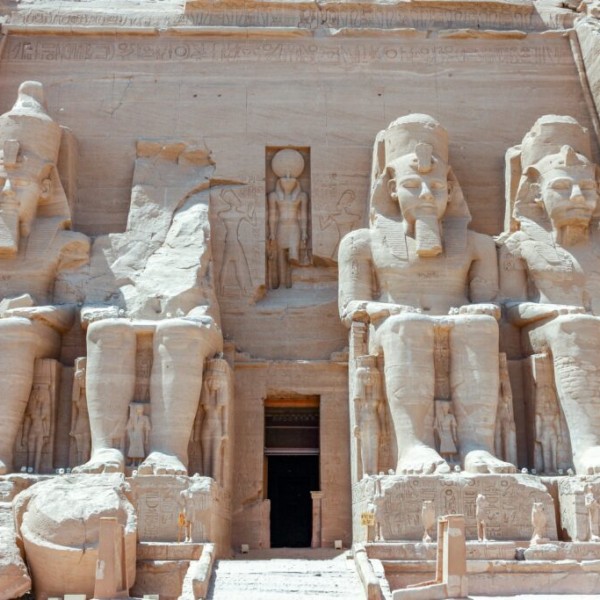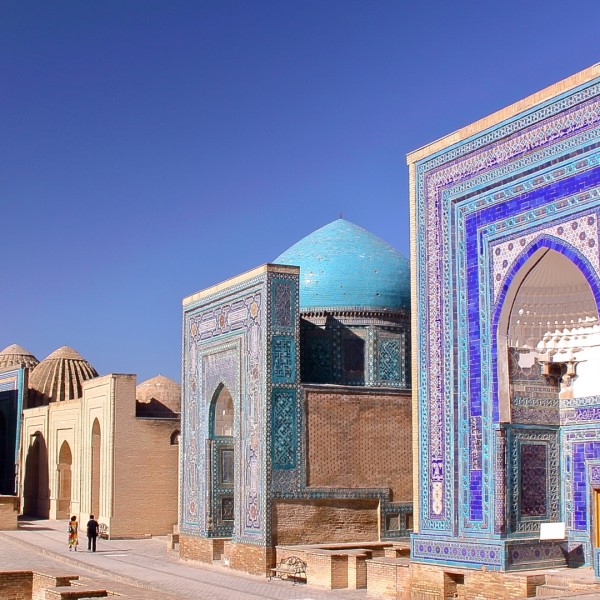Why book this trip?
Watch as Europe slowly transforms into Africa as you travel by train through France, Spain and Morocco. See Moorish heritage come to life in Andalucia, walk on the Camino de Santiago from San Sebastian, and explore Morocco’s Imperial Cities of Fes, Rabat and Marrakech. From baroque Bordeaux to the characteristic minarets and medinas of Morocco, travelling by rail is the stylish way to arrive at Marrakech.
- Food – Taste wine in Bordeaux, share authentic Spanish tapas and try flavoursome Moroccan tagine
- Spanish contrasts – Compare the faded glamour of San Sebastian with white-washed Andalucian villages and Moorish Granada
- Marrakech – Explore the busy souqs of the ‘Red City’ and the iconic Djemma El-Fna Square
Itinerary
- DAY 1 – Trip starts at London St. Pancras Station; Meet group in Paris and train to Bordeaux
-
Our trip begins this morning at London’s St Pancras Station, the home of the Eurostar. Here you’ll check-in for your Eurostar train and board your (unaccompanied) Eurostar train to Paris. You will have your tickets before you travel.
We meet our Tour Leader off the train at the Gare du Nord, and take the Paris metro together to the Gare Montparnasse. Here we board our train to Bordeaux, flying through the French countryside and saying ‘bonjour’ to the French coast after arriving in the late afternoon.
- DAY 2 – Wine-tasting in Bordeaux; afternoon at leisure
-
The small port city of Bordeaux is one of France’s most renowned wine-making hubs. This morning we’ll visit the Wine and Trade museum, in the heart of the wine merchants’ quarter, where we’ll get a real introduction into Bordeaux’s long reputation for making world-class wines. The visit takes us into the cellars of an old wine merchant’s house, bringing the history alive. We’ll end our tour with a tasting, of course, learning about what makes Bordeaux wine so special.
After our trip to the wine and trade museum, we’ll take an orientation tour through the historic centre of Bordeaux, which is full of beautifully-preserved 18th Century architecture and rambling pedestrian streets. After our walk through the city, we have the rest of the afternoon free to explore at our own pace. Walk down the Quais or visit the many trails in the large botanical garden just across the river. The Musee d’Aquitaine is a good option for people interested in learning more about the vast history of this region. Or if you still haven’t got your fill of wine, the multi-million pound Cite du Vin is an absolute monster – the museum chronicles a journey through centuries of wine production across the world.
- DAY 3 – Train to San Sebastian, Spain; walking tour and optional evening Pintxos crawl
-
We cross the border into Spain today, taking first a French train to the frontier town of Hendaye, nestled between the Atlantic and the Pyrenees. From here, we switch to a local Spanish train which takes around 30 minutes to San Sebastian, calling at intermittent small villages en route.
We’ll arrive into San Sebastian in the afternoon. Known locally as Donostia, this small town exudes Basque charm and a faded opulence. Once the go-to holiday spot for the Spanish monarchy, San Sebastian is dense with Belle-Epoque architecture, yet without being stuffy or grand. With a crescent-shaped beach and flanked by mountains, the setting is reminiscent of Rio de Janeiro.
After checking into the hotel, we’ll set out on a short walk with theTour Leader. We’ll just stroll a little way around the bay to the Peine del Viento, a series of three steel sculptures by local artist Eduardo Chillida, which give excellent panoramic views of the entire ‘concha’ (the crescent-shaped bay). For those who wish, there may be time to take the 19th-century funicular to the top of Monte Igueldo.
Controversial though it is, San Sebastian could be the best place in Spain to eat. The locals are seemingly obsessed with food, and there is no better place to experience this than at the city’s Pintxos bars. Plates piled high with different ‘Basque tapas’ line up along the bars, and locals shout their orders from the blackboard menus. Just a couple at a time suffice, washed down with a beer or wine. You have the option this evening to head out with your Tour Leader to taste Pintxos, or if you’d prefer to explore solo then your Leader can give you some recommendations. Before we visit the pintxos bars, we’ll explore the narrow streets of the beautiful Old Town, including the Plaza de la Constitucion and the Basilica of Saint Mary.
- DAY 4 – Walk on the famous Camino de Santiago to Pasaia; free afternoon in San Sebastian
-
The Camino de Santiago, or St James’ Way, is one of the most famous medieval pilgrimage routes in the world, linking up religious pilgrims with the Cathedral of Santiago de Compostela in Galicia. However, this famous walk is not just one single route. While the ‘Camino Frances’ is the most well-known and popular route, hiked by around 60% of pilgrims, we are going to do a half-day hike on the Camino Norte today, starting in San Sebastian and ending in the small fishing village of Pasaia (walking in the opposite direction of the pilgrims).
We’ll take a public bus to the eastern end of San Sebastian where our walk begins. The initial section out of San Sebastian is an uphill walk, with many steps to undertake before hitting a woodland section and continuing uphill on a forest path. This gets us up onto the headland, where the path levels out and hugs the coast with some fantastic views over the Atlantic. At the end of the walk we descend past the Silver Lighthouse (Faro de la Plata) into the charming little harbour village of Pasaia. We’ll take a three-minute ferry boat across the harbour to Old Pasaia, where there are some excellent fish restaurants near the water. The walk today will take us approximately four hours, with around 450 metres of ascent. The first uphill section is strenuous, but after this it levels off along the coast. The path varies between stone steps, rocky sections and dirt trail.
After lunch we’ll take the three-minute ferry back and catch a bus or train back to San Sebastian (approximately a 15-20 minute journey).
For those who don’t want to do the walk, there is so much to enjoy in San Sebastian. The San Telmo Museum has some permanent collections that showcase Basque art and history, with frequent interesting temporary exhibitions. A stroll along the white sands of ‘La Concha’ is ideal for people watching and relaxing on a summer day, while the harbour and the old town are bustling with restaurants and cafes.
- DAY 5 – Train to the ancient UNESCO-listed city of Segovia; explore on foot
-
Today we take a morning train to the stunning UNESCO world heritage historic city of Segovia. The train takes around five hours, and we’ll arrive in the early afternoon, leaving us plenty of time to explore the city on foot with our Tour Leader.
With its huge 1st century Roman Aqueduct, and Disney-like Alcazar Fortress, Segovia is an impressive city. The upper old town, encircled by ancient walls, is centred around the Plaza Major and 16th century Gothic cathedral, from where streets lead to the famed monuments. The magnificent Aqueduct is the defining feature of the city, spanning 17 kilometres and made up of 166 arches. During our walking tour we’ll see this in all its glory, as well as walking on some of the old walls surrounding the city.
- DAY 6 – Free time in Segovia; afternoon train to Malaga via Madrid
-
We have free time in Segovia this morning, which is time very well spent. Walking up to the hilltop Alcazar is worth it for the views over the city and rivers and to admire the slate turrets, the beautiful keep and square with four towers.
In the afternoon we take a quick train to Madrid, and catch the Renfe (underground system) between Madrid Chamartin Station and Madrid Atocha, where we pick up our onward connection to Malaga, arriving in the evening.
Malaga has an ‘interesting’ reputation among UK holiday-goers, who normally land there before journeying outside the city to stay at a beach resort. This is a shame, because the historic downtown area of the city is very attractive, and mainly pedestrianised. We’ll most likely visit this area for dinner this evening.
- DAY 7 – Free day in Malaga
-
This morning we bid farewell to some of our travelling companions who are leaving us in Malaga, while the rest of the day is free to discover the city. As a major gateway to the Costa del Sol, many holiday-goers simply blow through on their way to a beachside hotel. In doing so they miss the superb art, food and architecture that Malaga has to offer – a trip to the old town reveals cobbled streets, baroque architecture, a Roman theatre and traditional bodegas serving tasty tapas. The Atarazanas Market is also a fantastic stop for food-lovers, hosted in a 14th century shipbuilding yard, with enormous stained glass windows that provide a visual treat. If you are interested in art, the Picasso Museum is truly excellent; the collection represents his entire life’s work and is housed in the 16th-century Buenavista Palace. Tickets should be purchased online prior to arrival. Alternatively, you may simply wish to spend the day relaxing at the beach after a week of travel.
This evening, we will be joined by new group members who are beginning their journey in Malaga and travelling to Marrakech. The Tour Leader intends to do a welcome meeting at 7pm this evening and, for those who wish, there is the chance to go out for dinner. Andalucia is renowned for its authentic tapas culture, and Malaga has many excellent tapas bars to discover.
- DAY 8 – To Cordoba; discover the old town and explore the remarkable Mezquita
-
Today we transfer to Cordoba (by train or bus, depending on availability). Standing on the banks of the Guadalquivir river, Cordoba was one of the most sophisticated Moorish cities and is for many, the most beautiful city in Spain. The Arabs established themselves in Cordoba as early as 719 AD, and before that the Romans had left their own mark here. Cordoba has a wealth of treasures locked away in its back streets with secluded patios tucked behind delicate iron grills. The medieval synagogues in Cordoba and Toledo are the only two which remain in Spain today and Cordoba synagogue dates back to the 14th century. This afternoon we visit the renowned Mosque (Mezquita), an extraordinary and unique building where history has superimposed two faiths and erected two oratories on the one site (local guide optional). The early massive structure dates back to the 8th century, its roof supported by a forest of 850 coloured columns. Its jewel is the gleaming and superbly decorated Mihrab, which has survived in its original state. In the evening we suggest you take in some traditional flamenco music and dancing (optional).
- DAY 9 – Explore Granada including the old Moorish Quarter
-
Today we transfer to Granada by public bus and spend the afternoon exploring the city on foot, discovering the main points of interest including the Albaicin, the old Moorish quarter where many Islamic traditions are retained, giving the city its characteristic look of white walls and narrow streets. From the highest point are spectacular views across to the Alhambra and Generalife with the Sierra Nevada as a backdrop. When dusk falls, we suggest a stroll around the old Moorish Quarter to see its illuminated patios.
- DAY 10 – Chance to visit the magnificent Alhambra Palace; afternoon train to Ronda
-
This morning has been left free for your own exploration of Granada or you have the option to visit the magnificent Alhambra Palace. In 1239 Muhammad al-Ahmar, founder of the Nasrid dynasty and Sultan of Granada, began work on this, the finest example of Moorish architecture outside the Arab world. The fabulous decoration in stucco, both inside and outside the buildings, reveals the purest expression of a sophisticated civilisation just before its decline. You might also choose to spend time in the Generalife, one of the most beautiful landscaped gardens in the world, surrounding the summer residence of the Caliphs.
Later this afternoon we travel to Antequera by public bus and then catch our train from here to Ronda.
Please note that the visit to the Alhambra Palace is optional because it can no longer be guaranteed that group tickets can be secured to visit the palace. It is much simpler for you to book your own individual entrance tickets online for the Alhambra Palace. Bookings for this open at 90 days prior and you will need to book your ticket in advance on the website rather than waiting to when you are on tour. You can book your entrance ticket on day three from 3.30pm onwards or for this morning, but no later than 1.30pm. Further details can be found in the Optional Activities section of the Trip Notes.
- DAY 11 – Visit the picturesque Andalucian ‘pueblo blancos’ (white villages) of Zahara La Sierra and Grazalema
-
We spend the day exploring the beautiful rolling landscapes west of Ronda by bus. Arriving at the fortified Moorish hill village of Zahara is like stepping back in time. Its whitewashed terraces are dominated by an impressive Moorish tower and a Baroque church lies at the heart of the village. We also plan to visit Grazalema, nestled beneath the limestone peak of San Cristobal. We return to Ronda and spend an afternoon in one of southern Spain’s most attractive towns. Ronda is one of the original pueblos blancos (white towns). There will be time to wander the streets and marvel at the El Tajo gorge and visit the oldest bullring in Spain.
- DAY 12 – Travel by train through rolling countryside; take a ferry to Tangier and visit the medina
-
We travel the attractive Andalucia Express route south from Ronda towards the coast through rolling countryside via the painted villages of San Roque, Castellar de la Frontera and Gaucin. On arrival at Algeciras, we transfer to the ferry port where we will say goodbye to our Spanish local leader and catch an early afternoon ferry across the Straits of Gibraltar to Tangier in Morocco.
On arrival in Tangier, we will be met by our local leader and taken to our hotel to check in. After a short break to drop our belongings off to our rooms and get some lunch, we’ll head out with our leader to immerse ourselves in the vibrancy and heady atmosphere of a Moroccan medina. We’ll be guided through the network of narrow streets that make up the medina on foot for a couple of hours before transferring back to our hotel. The evening will be free to relax or explore independently. The contrast between the calm streets and squares of Ronda and the more energetic atmosphere of Tangier is quite incredible.
- DAY 13 – To Fes, the cultural capital of Morocco
-
After breakfast we will make our way to the train station to meet the train to Fes, the cultural capital of Morocco. Fes’ colourful history is full of wars, murders, intrigue and cloak-and-dagger politics, so after checking in and some time to get lunch nearby to the hotel, we’ll set off into the city to start exploring.
Around mid-afternoon we will begin a two hour orientation tour by bus, visiting the Royal Palace, the viewpoint by the Merenid Tombs and an operational pottery factory by bus. Entrance inside the Royal Palace is not allowed, however, the seven grand golden gates make the visit worthwhile. Beautifully intricate and framed by traditional Zellige tiles, the gates give a hint to how ornate the inside of the palace must be and are a great place to take a photo that captures the essence of Fes. The Merenid Tombs are perched on a hill above Fes and although there is little known history about the tombs themselves it’s believed they date back to the 14th century. While the ruins are a point of interest, the elevated viewpoint is the highlight, offering sweeping views to the city below, and with help of our leader we should be able to make out the different parts of the city.
Fes also has quite an active nightlife, centred around Avenues Hassan ll and Mohammed V. We enjoy two nights here to take in all the city has to offer.
- DAY 14 – Guided walking tour of Fes through its souks and tanneries; visit Roman site of Volubilis
-
After breakfast at the hotel we will take a guided walk through the Medina. We will explore the souks’ craft areas, spice stalls, brass and copperware areas and look in on the very smelly but iconic tanneries. Beautiful buildings include the Sanctuary of Moulay Idriss 2nd, the Kairaouine Mosque and the Al Andalus Mosque (viewed from the outside only). We’ll be walking for approximately 3 hours before lunch, and our guide will give some recommendations of where to eat both inside and outside of the medina.
This afternoon, we will re-join our bus and travel to Meknes. One of the four Imperial Cities, Meknes is only 45 minutes from Fes and the old part of the city boasts a quiet, charming atmosphere. We’ll spend a short time here to take in the city’s ornate riads, spice-scented alleyways and visit the Royal Stables which is said to have once been home to 12,000 prized royal horses during Moulay Ismail’s reign in the 17th Century.
- DAY 15 – Train to Rabat; city tour through the highlights of the atmospheric capital city
-
This morning we catch the morning train to the modern capital of Rabat, where we’ll arrive in time for lunch. Although it was only established as the capital in 1912 by the French, Rabat’s history stretches back to a settlement in the 8th century BC. On arrival we’ll have some time for lunch before we spend a couple of hours on a guided tour with a mix of short bus transfers and walking.
We’ll visit Rabat’s iconic Hassan Tower which has been in the same state of construction since 1199 when Sultan Yaqoub al Mansour died. Despite the fact it’s not yet finished it’s still worth the visit; building commenced with the intention that it would be the tallest minaret in the world and inside there are ramps that were put in place so the muezzin (servant of the mosque) would be able to ride a horse up to call everyone for prayers. The tower is located at one end of a large esplanade that is filled with 200 marble columns and was built to be large enough for the Sultan’s entire army to attend prayer, while the Mohammed V Mausoleum dominates the other end of this plaza.
- DAY 16 – Train to Marrakech via Casablanca; chance to visit the famous King Hassan II Mosque
-
This morning we will take a train to Casablanca to visit the famous King Hassan II Mosque (optional entry), possibly the biggest religious monument for Muslims after Mecca. Finished in 1993, this magnificent building is covered in decorative Zellige tiles and has intricate cedar wood carvings – proof that the ancient crafts are still very much alive. After visiting the mosque we will have some free time to get lunch, before returning to the train station for our next leg to Marrakech, the heart of Morocco. The train ride will take most of the afternoon, on arrival we’ll check into our hotel and the evening will be free.
- DAY 17 – Walking tour of Marrakech through colourful souks and the iconic Djemaa el Fna Square
-
Marrakech is a feast for the senses. Like many North African towns, Marrakech is divided into two distinct parts; Gueliz, the more modern French-influenced area and the Medina, the old city. It has always been a meeting place for the mountain Berbers and the desert peoples of the South and the colourful souks perfectly illustrate this fact.
This morning a local guide will take us for a walking tour of the old city. Taking a closer look at the maze of narrow streets filled with the sounds, colours and smells of the exotic and an opportunity to visit the iconic Koutoubia Tower. After a morning of sightseeing, we’ll stop in time for lunch and the rest of the day will be free.
During a free afternoon it is worth visiting are the Saadian Tomb, the Dar Si Said Palace (now Museum of Moroccan Art), the Menara Gardens or the Majorelle Gardens including the Museum of Islamic Art a short taxi ride away. By night Marrakech comes alive and no trip to the city is complete without a visit to the celebrated Djemaa el Fna Square, a spectacle not to be missed with many street performers it’s reminiscent of a scene straight out of the pages of Arabian Nights.
- DAY 18 – Free time in Marrakech; chance to join a day trip to the High Atlas
-
Today is free to explore the city further at your own pace. Alternatively, for a complete change of scenery, you may choose to go on an optional visit to a nearby High Atlas village today. The High Atlas is North Africa’s greatest mountain range. Populated by Berber tribesmen, it has always been an area culturally removed from the rest of Morocco, a barrier between the northern plains and the pre-Sahara.
- DAY 19 – Trip ends Marrakech
-
The trip ends after breakfast at our hotel in Marrakech.
There are no activities planned today, so you are free to depart from Marrakech at any time. If your flight is departing later in the day, luggage storage facilities are available at our hotel. If you would like to receive a complimentary airport transfer today, you need to depart from Marrakesh Menara Airport (RAK).
Depending on the schedule of your flights, you may have some additional time to wander in the souks of Marrakech or buy your last souvenirs before departure.
Images courtesy of Explore Worldwide
EXW – RLMO

















